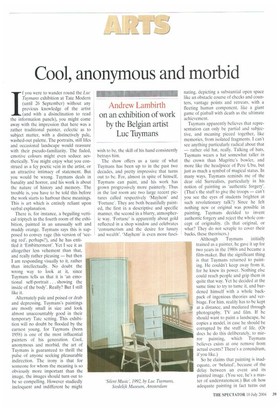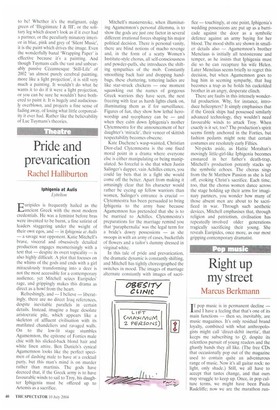Cool, anonymous and morbid
Andrew Lambirth on an exhibition of work by the Belgian artist Luc Tuymans 1 f you were to wander round the Luc Tuymans exhibition at Tate Modern (until 26 September) without any previous knowledge of the artist (and with a disinclination to read the information panels), you might come away with the impression that here was a rather traditional painter, eclectic as to subject matter, with a distinctively pale, washed-out palette. The portraits, still lifes and occasional landscape would reassure with their pseudo-familiarity. The faded, emotive colours might even seduce aesthetically. You might enjoy what you construed as a fey poetic vein in the artist, or an attractive intimacy of statement. But you would be wrong. Tuymans deals in banality and horror, and his work is about the nature of history and memory. The trouble is, you have to be told this before the work starts to harbour these meanings. This is art which is entirely reliant upon verbal explanation.
There is, for instance, a beguiling vertical triptych in the fourth room of the exhibition, painted in an unusually soft and muddy orange. Tuymans says this is supposed to convey rage (his version of 'seeing red', perhaps?), and he has entitled it 'Embitterment'. Yet I see it as altogether less vehement than that, and really rather pleasing — but then I am responding visually to it, rather than intellectually. No doubt the wrong way to look at it, since Tuymans tells us that it is `an emotional self-portrait. . . showing the inside of the body'. Really? But I still like it.
Alternately pale and poised or drab and depressing, Tuymans's paintings are mostly small in size and look almost unaccountably good in their temporary Tate setting. This exhibition will no doubt be flooded by the earnest young, for Tuymans (born 1958) is one of the most influential painters of his generation. Cool, anonymous and morbid, the art of Tuymans is guaranteed to thrill the pulse of anyone seeking pleasurable indirection. The irony is that for someone for whom the meaning is so obviously more important than the image, the images should turn out to be so compelling. However studiedly ineloquent and indifferent he might wish to be, the skill of his hand consistently betrays him.
The show offers us a taste of what Tuymans has been up to in the past two decades, and pretty impressive that turns out to be. For, almost in spite of himself, Tuymans can paint, and his work has grown progressively more painterly. Thus in the last room are two large recent pictures called respectively `Mayhem' and 'Fortune'. They are both beautifully painted, the first in a descriptive and specific manner, the second in a blurry, atmospheric way. 'Fortune' is apparently about gold reflected in a shop window and celebrates 'consumerism and the desire for luxury and wealth'. 'Mayhem' is even more fasci
nating, depicting a substantial open space like an obstacle course of checks and counters, vantage points and retreats, with a fleeting human component, like a giant game of pinball with death as the ultimate achievement.
Tuymans apparently believes that representation can only be partial and subjective, and meaning pieced together, like memories, from isolated fragments. I can't see anything particularly radical about that — rather old hat, really. Talking of hats, Tuymans wears a hat somewhat taller in the crown than Magritte's bowler, and more like the headpiece of Pere Ubu, but just as much a symbol of magical status. In many ways, Tuymans reminds me of the dear old Surrealists, particularly in his notion of painting as 'authentic forgery'. (That's the stuff to give the troops — can't you see the eyes of students brighten at such revolutionary talk?) Since he felt nothing new or original was possible in painting, Tuymans decided to invent authentic forgery and reject the whole concept of originality. (Is that original, or what? They do not scruple to cover their backs, these theorisers.) Although Tuymans initially trained as a painter, he gave it up for two years in the 1980s and became a film-maker. But the significant thing is that Tuymans returned to painting. He couldn't keep away from it, for he knew its power. Nothing else could reach people and grip them in quite that way. Yet he decided at the same time to try to tame it, and burdened himself with a whole backpack of ingenious theories and verbiage. For him, reality has to be kept at a distance, and mediated through photography, TV and film. If he should want to paint a landscape, he copies a model, in case he should be corrupted by the stuff of life. (Or does he do this deliberately, to mirror painting, which Tuymans believes exists at one remove from actual events? There's a conundrum, if you like.) So he claims that painting is inadequate, or 'belated', because of the delay between an event and its painted image. (You see, he's a master of understatement.) But oh how adequate painting in fact turns out
to be! Whether it's the malignant, edgy green of 'Illegitimate I & III', or the solitary leg which doesn't look as if it ever had a partner, or the peculiarly minatory interior in blue, pink and grey of 'Silent Music', it is the paint which drives the image. Even the wonderfully banal 'Wrapping Paper' is effective because it's a painting. And though Tuymans calls the vast and unbearably passive Cezannesque Still-Life' of 2002 'an almost purely cerebral painting, more like a light projection', it is still very much a painting, It wouldn't do what he wants it to do if it were a light projection, or you can be sure he wouldn't have bothered to paint it. It is hugely and audaciously overblown, and projects a fine sense of fading away, of losing what little corporeality it ever had. Rather like the believability of Luc Tuymans's theories.



























































 Previous page
Previous page